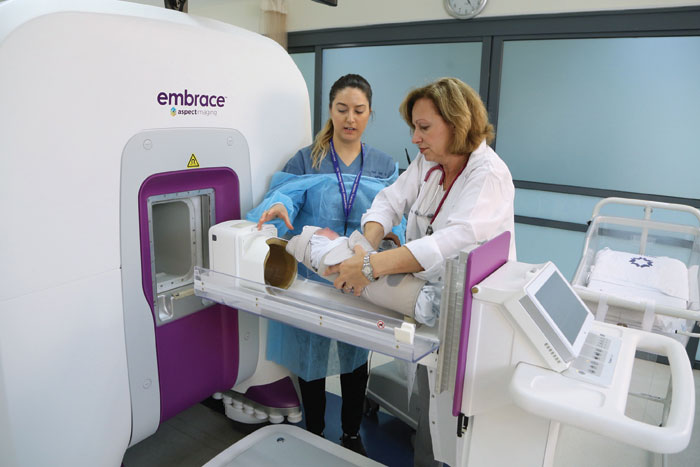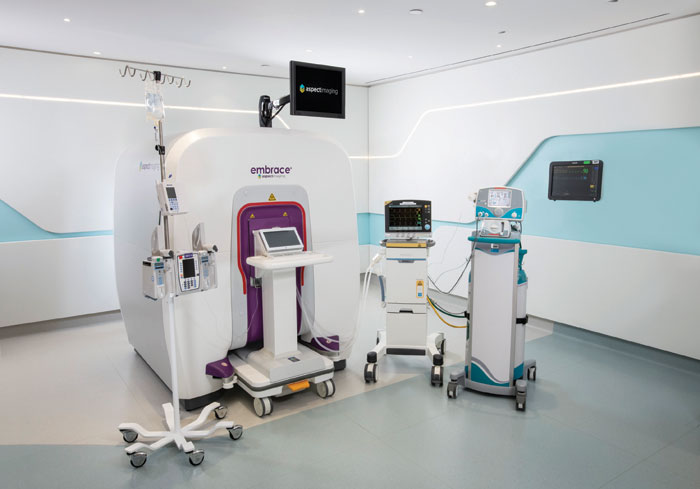Embrace neonatal MRI system: mitigating infection risk in the NICU
Despite the vigilance applied to infection prevention, NICUs are forced to accept unnecessary risks and transport fragile infants out of the controlled environment of the NICU to the radiology department when an MRI is needed. In many cases, this is the only time a baby is moved from the NICU prior to discharge from the hospital.
The need to avoid healthcare-associated infections (HCAI) and their associated complications is well understood, especially when caring for the most fragile patients in neonatal intensive care units (NICU). Aggressive policies and procedures relying on clinical team members to thoroughly clean and disinfect equipment, and the adoption of visitation policies designed to limit the neonate’s exposure to non-parental visitors and staff, are routinely employed in NICUs today.
Despite the vigilance applied to infection prevention, NICUs are forced to accept unnecessary risks and transport fragile infants out of the controlled environment of the NICU to the radiology department when an MRI is needed. In many cases, this is the only time a baby is moved from the NICU prior to discharge from the hospital.
An evaluation of outcomes during intra-hospital neonatal transport showed that 27% of patients transported for radiology services suffered complications.1 In addition to the risk of clinical instability while transporting sick neonates through the hospital to the MRI suite, the transport exposes them to public and clinical areas that primarily serve other patient populations and increase their risk for exposure to infectious microorganisms and cross-contamination. In 2013, the American College of Radiology alerted hospitals to the importance of infection control in MRI facilities.2 More recently, a paper in the Journal of Medical Imaging highlighted how deficiencies in infection prevention precautions exist in many radiology departments worldwide.3
“Any exposure to infection, even a simple sneeze or cough from a person in a hallway or elevator, can mean life or death for a baby who has been in the NICU since birth, is not immunised and may have respiratory issues,” says Patricia G. Bondurant, DNP, RN, Co-founder and Chief Transformation and Quality Officer, TransForm Healthcare Consulting LLC. Dr Bondurant is a nationally recognised expert in healthcare management, neonatal and paediatric nursing, and quality improvement. Her work has resulted in improved care and outcomes for neonates and children and she was a key stakeholder and nursing lead in the development and implementation of the American Academy of Pediatrics NICU Levels of Care Verification Program.

The custom-designed infant bed provides a secure, temperature-controlled environment with quick access.
Transforming neonatal neuro imaging inside the NICU
Modern hospital design is based on providing the best possible care for patients. Faster access to services, improved patient experience, greater workflow efficiency – all of these goals are considered when designing clinical areas in the hospital. NICUs now include many services within their department: pharmacy, respiratory, laboratory, even surgical suites, to provide care to critically ill neonates in the unit without transport. While initially driven by the need to increase timely access to services, the benefit of keeping babies in the NICU is no longer strictly a convenience or a way to increase workflow efficiency. It is more critical than ever to keep babies, and those services they require, within the protected environment of the NICU and avoid the added risk of intra-hospital transport for any reason.
“The most important point is to not move the baby,” adds Dr Bondurant. “In the US, higher level NICUs have dedicated ultrasound and X-ray machines to prevent infection transmission because we know that when a machine travels around a hospital it could be a vector for infections. So why should we change our practice when it comes to MRI, and not have it as contained as the rest of the NICU? It draws a natural conclusion that we should have a dedicated MRI in the NICU.”
Today, that risk to move a baby from the NICU to an MRI in the radiology department is magnified with the heightened concern of COVID-19, a novel coronavirus causing widespread infection, especially with MRI equipment in most hospitals being located a great distance from the NICU, requiring long transport of babies through the hospital.4 According to Dr Bondurant, she’s hearing from colleagues who report they are more reluctant to order MRI scans and, in some cases, postponing the exam until after discharge during the COVID-19 healthcare crisis.
Yet, delaying an MRI for a NICU patient can impact not only their diagnosis, but also their development. It’s important, Dr Bondurant says, that parents have access to habilitative services for their child as soon as possible, especially when long-term services are needed to maximise a baby’s development. The extent of an injury may not be known unless the infant has an MRI, which is more specific than an ultrasound or X-ray and is a standard of care for diagnosing brain and spinal injuries.5
As concern for minimising infection risks to the most fragile patients increases, the option of providing care to neonates without leaving the NICU has transitioned from a nice-to-have approach, to a must-have approach to mitigate the risk of infection for patients at the highest risk of complications.
That’s where Aspect Imaging’s Embrace, the only FDA 510(k) and CE approved dedicated neonatal MRI system, can make a world of difference for the health and development of critically ill infants. Uniquely designed to be placed within the NICU, the Embrace offers the critically valuable, timely diagnostic information only available from MRI, without the acknowledged risk of taking the baby out of the NICU.

The Embrace system’s small footprint and unique design allows NICU equipment, staff and parents to remain close.
“The Embrace Neonatal MRI allows us to do things we couldn’t do before because of the risks of moving a baby down to the MRI suite,” says Dr Bondurant. “It gives us timely information that will allow us to provide habilitative, early intervention services when needed. Without the Embrace we are forced to compromise our practice and transport the baby from the safe, sterile environment of the NICU to get their MRI. We shouldn’t be breaking the practices that we so heartedly put into place to protect these babies in every way possible when there is another option.”
For further information on the Embrace® neonatal MRI system visit: embracemri.com
Embrace® is a registered trademark of Aspect Imaging, Ltd. Aspect Imaging is a global leader in the design and development of compact, high quality MR imaging solutions, designed for use in pre-clinical research and medical applications. ©2020 Aspect Imaging, Ltd. All rights reserved. DOC10002192
Or read this article in our
Tablet/iPad edition


